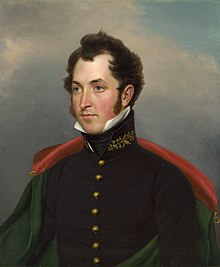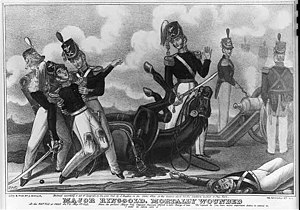| Samuel Ringgold | |
|---|---|
 Samuel Ringgold by John Vanderlyn, c. 1825 Samuel Ringgold by John Vanderlyn, c. 1825 | |
| Born | 1796 Maryland |
| Died | May 11, 1846 Port Isabel, Texas |
| Place of burial | Green Mount Cemetery, Baltimore |
| Allegiance | |
| Service | |
| Years of service | 1818–1846 |
| Rank | |
| Unit | |
| Battles / wars | Mexican–American War |
| Relations | Samuel Ringgold (Father) Cadwallader Ringgold (Brother) |
Samuel B. Ringgold (1796 – May 11, 1846) was an artillery officer in the United States Army who was noted for several military innovations which caused him to be called the "Father of Modern Artillery." He was also, according to some records, the first U.S. officer to fall in the Mexican–American War, perishing from wounds received at the Battle of Palo Alto.
Early life and career
Ringgold was the son of Samuel Ringgold, a U.S. Congressman from Maryland. A younger brother, Cadwalader Ringgold, served in the navy, becoming a rear admiral.
On July 24, 1818, Samuel Ringgold graduated 5th in a class of 23 from the United States Military Academy at West Point. He was commissioned a Second Lieutenant in the Artillery.
In the early 1820s, Ringgold was on the staff of General Winfield Scott. At about that time, (roughly 1825) John Vanderlyn, then working in New York City, painted Ringgold's portrait.
Ringgold's significant military innovations included the Ringgold military saddle and artillery techniques. Based on his research in Europe, he rewrote the Army's manual for artillery, which included the tactical concept of flying artillery—employing artillery pieces that could be moved quickly from place to place. The Army adapted his manual, "Instructions for Field Artillery" on March 6, 1845, and he was promoted to the rank of Major in acknowledgment of his military innovations.
Mexican–American War
Ringgold served in General Zachary Taylor's occupation force in Texas as a Major of Artillery. On May 8, 1846, as he and 2,400 troops were en route to Fort Texas, they were engaged at the Battle of Palo Alto by Mexican General Mariano Arista and his force of 3,800 men.
Arista's army was stretched a mile wide, making an American bayonet charge, Taylor's first option, impossible. Taylor, in an unlikely move, advanced his artillery to attack the enemy. The use of Ringgold's flying artillery tactic won the battle for the Americans. The Mexican artillery, heavy and slow, was futile in the thick steel-wool brush at Palo Alto. Arista ordered cavalry charges to flank the artillery gunners, but the American flying artillery was able to mobilize, relocate, and repel the oncoming dragoons.
During the battle, Ringgold was mortally wounded by cannon fire that mangled both his legs just below the crotch. Nevertheless, he refused to leave the field during the battle. He survived three days, during which time he debriefed on the battle, before dying in Port Isabel, Texas.
Robert D'Unger, then journalist at the Baltimore Democrat, claimed that he was the first to report news by telegraph while reporting Ringgold's death.
Commemoration

His bravery was a boost to morale through the military and the country. Songs, poetry, plays were written about him, including a mention in the fourth verse of Maryland, My Maryland. A song entitled "The Death of Ringgold," commemorating his death, was a popular patriotic song in the US during the war. John H. Hewitt wrote a song, "On to the Charge", and dedicated it to the late Major Ringgold.
Cities and counties were named in his honor, including:
- Ringgold, Georgia (Catoosa County seat)
- Ringgold, Louisiana
- Ringgold, Virginia
- Ringgold, Maryland
- Ringgold Township, Pennsylvania
- Ringgold County, Iowa
- New Ringgold, Pennsylvania
Also:

- The Ringgold Civic Park in Brownsville, Texas was named after him as well as Ringgold Street at the University of Texas at Brownsville.
- Fort Ringgold, constructed after the Mexican War in 1848 to protect the Mexican border, was named after him. It is located in Rio Grande City, Texas. The Fort is currently the home of Ringgold Elementary and the Rio Grande City Grulla Independent School District Headquarters.
- U.S. Army Mine Planter Major Samuel Ringgold built 1904.
- Ringgold Fire Company, Pulaski, New York.
Family tree
| Cadwalader family tree | |||||||||||||||||||||||||||||||||||||||||||||||||||||||||||||||||||||||||||||||||||||||||||||||||||||||||||||||||||||||||||||||||||||||||||||||||||||||||||||||||||||||||||||||||||||||||||||||||||||||||||||||||||||||||||||||||||||||||||||||||||||||||||||||||||||||||||||||||||||||||||||||||||||||||||||||||||||||||||||||||||||||||||||||||||||||||||||||||||||||||||||||||||||||||||||||||||||||||||||||||||||||||||||||||||||||||||||||||||||||||||||||||||||||||||||||||||||||||||||||||||||||||||||||||||||||||||||||||||||||||||||||||||||||||||||||||||||||||||||||||||||||||||||||||||||||||||||||||||||||||||||||||||||||||||||||||||||||||||||||||||||||||||||||||||||||||||||||||||||||||||||||||||||||||||||||||||||||||||||||||||||||||||||||||||||||||||||||||||||||||||||||||||||||||||||||||||||||||||||||||||||||||||||||||||||||||||||||||||||||||||||||||||||
|---|---|---|---|---|---|---|---|---|---|---|---|---|---|---|---|---|---|---|---|---|---|---|---|---|---|---|---|---|---|---|---|---|---|---|---|---|---|---|---|---|---|---|---|---|---|---|---|---|---|---|---|---|---|---|---|---|---|---|---|---|---|---|---|---|---|---|---|---|---|---|---|---|---|---|---|---|---|---|---|---|---|---|---|---|---|---|---|---|---|---|---|---|---|---|---|---|---|---|---|---|---|---|---|---|---|---|---|---|---|---|---|---|---|---|---|---|---|---|---|---|---|---|---|---|---|---|---|---|---|---|---|---|---|---|---|---|---|---|---|---|---|---|---|---|---|---|---|---|---|---|---|---|---|---|---|---|---|---|---|---|---|---|---|---|---|---|---|---|---|---|---|---|---|---|---|---|---|---|---|---|---|---|---|---|---|---|---|---|---|---|---|---|---|---|---|---|---|---|---|---|---|---|---|---|---|---|---|---|---|---|---|---|---|---|---|---|---|---|---|---|---|---|---|---|---|---|---|---|---|---|---|---|---|---|---|---|---|---|---|---|---|---|---|---|---|---|---|---|---|---|---|---|---|---|---|---|---|---|---|---|---|---|---|---|---|---|---|---|---|---|---|---|---|---|---|---|---|---|---|---|---|---|---|---|---|---|---|---|---|---|---|---|---|---|---|---|---|---|---|---|---|---|---|---|---|---|---|---|---|---|---|---|---|---|---|---|---|---|---|---|---|---|---|---|---|---|---|---|---|---|---|---|---|---|---|---|---|---|---|---|---|---|---|---|---|---|---|---|---|---|---|---|---|---|---|---|---|---|---|---|---|---|---|---|---|---|---|---|---|---|---|---|---|---|---|---|---|---|---|---|---|---|---|---|---|---|---|---|---|---|---|---|---|---|---|---|---|---|---|---|---|---|---|---|---|---|---|---|---|---|---|---|---|---|---|---|---|---|---|---|---|---|---|---|---|---|---|---|---|---|---|---|---|---|---|---|---|---|---|---|---|---|---|---|---|---|---|---|---|---|---|---|---|---|---|---|---|---|---|---|---|---|---|---|---|---|---|---|---|---|---|---|---|---|---|---|---|---|---|---|---|---|---|---|---|---|---|---|---|---|---|---|---|---|---|---|---|---|---|---|---|---|---|---|---|---|---|---|---|---|---|---|---|---|---|---|---|---|---|---|---|---|---|---|---|---|---|---|---|---|---|---|---|---|---|---|---|---|---|---|---|---|---|---|---|---|---|---|---|---|---|---|---|---|---|---|---|---|---|---|---|---|---|---|---|---|---|---|---|---|---|---|---|---|---|---|---|---|---|---|---|---|---|---|---|---|---|---|---|---|---|---|---|---|---|---|---|---|---|---|---|---|---|---|---|---|---|---|---|---|---|---|---|---|---|---|---|---|---|---|---|---|---|---|---|---|---|---|---|---|---|---|---|---|---|---|---|---|---|---|---|---|---|---|---|---|---|---|---|---|---|---|---|---|---|---|---|---|---|---|---|---|---|---|---|---|---|---|---|---|---|---|---|---|---|---|---|---|---|---|---|---|---|---|---|---|---|---|---|---|---|---|---|---|---|---|---|---|---|---|---|---|---|---|---|---|---|---|---|---|---|---|---|---|---|---|---|---|---|---|---|---|---|---|---|---|---|---|---|---|---|---|---|---|---|---|---|---|---|---|---|---|---|---|---|---|---|---|---|---|---|---|---|---|---|---|---|---|---|---|---|---|---|---|---|---|---|---|---|---|---|---|---|---|---|---|---|---|---|---|---|---|---|---|---|---|---|---|---|---|---|---|---|---|---|---|---|---|---|---|---|---|---|---|---|---|---|---|---|---|---|---|---|---|---|---|---|---|---|---|---|---|---|---|---|---|---|---|---|---|---|---|---|---|---|---|---|---|---|---|---|---|---|---|---|---|---|---|---|---|---|---|---|
| |||||||||||||||||||||||||||||||||||||||||||||||||||||||||||||||||||||||||||||||||||||||||||||||||||||||||||||||||||||||||||||||||||||||||||||||||||||||||||||||||||||||||||||||||||||||||||||||||||||||||||||||||||||||||||||||||||||||||||||||||||||||||||||||||||||||||||||||||||||||||||||||||||||||||||||||||||||||||||||||||||||||||||||||||||||||||||||||||||||||||||||||||||||||||||||||||||||||||||||||||||||||||||||||||||||||||||||||||||||||||||||||||||||||||||||||||||||||||||||||||||||||||||||||||||||||||||||||||||||||||||||||||||||||||||||||||||||||||||||||||||||||||||||||||||||||||||||||||||||||||||||||||||||||||||||||||||||||||||||||||||||||||||||||||||||||||||||||||||||||||||||||||||||||||||||||||||||||||||||||||||||||||||||||||||||||||||||||||||||||||||||||||||||||||||||||||||||||||||||||||||||||||||||||||||||||||||||||||||||||||||||||||||||
| |||||||||||||||||||||||||||||||||||||||||||||||||||||||||||||||||||||||||||||||||||||||||||||||||||||||||||||||||||||||||||||||||||||||||||||||||||||||||||||||||||||||||||||||||||||||||||||||||||||||||||||||||||||||||||||||||||||||||||||||||||||||||||||||||||||||||||||||||||||||||||||||||||||||||||||||||||||||||||||||||||||||||||||||||||||||||||||||||||||||||||||||||||||||||||||||||||||||||||||||||||||||||||||||||||||||||||||||||||||||||||||||||||||||||||||||||||||||||||||||||||||||||||||||||||||||||||||||||||||||||||||||||||||||||||||||||||||||||||||||||||||||||||||||||||||||||||||||||||||||||||||||||||||||||||||||||||||||||||||||||||||||||||||||||||||||||||||||||||||||||||||||||||||||||||||||||||||||||||||||||||||||||||||||||||||||||||||||||||||||||||||||||||||||||||||||||||||||||||||||||||||||||||||||||||||||||||||||||||||||||||||||||||||
Notes:
| |||||||||||||||||||||||||||||||||||||||||||||||||||||||||||||||||||||||||||||||||||||||||||||||||||||||||||||||||||||||||||||||||||||||||||||||||||||||||||||||||||||||||||||||||||||||||||||||||||||||||||||||||||||||||||||||||||||||||||||||||||||||||||||||||||||||||||||||||||||||||||||||||||||||||||||||||||||||||||||||||||||||||||||||||||||||||||||||||||||||||||||||||||||||||||||||||||||||||||||||||||||||||||||||||||||||||||||||||||||||||||||||||||||||||||||||||||||||||||||||||||||||||||||||||||||||||||||||||||||||||||||||||||||||||||||||||||||||||||||||||||||||||||||||||||||||||||||||||||||||||||||||||||||||||||||||||||||||||||||||||||||||||||||||||||||||||||||||||||||||||||||||||||||||||||||||||||||||||||||||||||||||||||||||||||||||||||||||||||||||||||||||||||||||||||||||||||||||||||||||||||||||||||||||||||||||||||||||||||||||||||||||||||||
References
- "Of Mythical Importance (U.S. National Park Service)". www.nps.gov. Retrieved 2024-05-05.
- ^ "Samuel Ringgold (1796-1846)". National Portrait Gallery. Archived from the original on 2009-04-19. Retrieved 2009-06-27.
- Lavender, David S. (2003). Climax at Buena Vista: The Decisive Battle of the Mexican–American War. University of Pennsylvania Press. ISBN 0-8122-1860-4.
- The Catoclin Clarion, June 17, 1871.
- Krakow, Kenneth K. (1975). Georgia Place-Names: Their History and Origins (PDF). Macon, GA: Winship Press. p. 189. ISBN 0-915430-00-2.
- McKnight, William James (1917). Historical. J.H. Beers. p. 491.
- "City of Brownsville - Ringgold Civic Pavilion at Dean Porter Park". rcp.cob.us. Archived from the original on 28 February 2009. Retrieved 19 August 2010.
External links
- Samuel Ringgold, Mexican–American War Officer
- Military biography of Samuel Ringgold from the Cullum biographies
- Daguerreotype